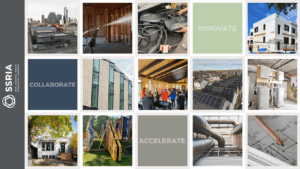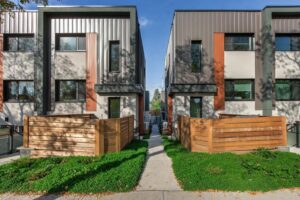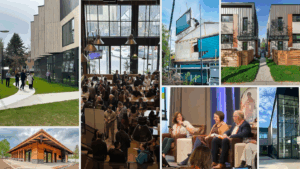Green Building Technology Network
Projects Sponsor
Four years ago, the Smart Sustainable Resilient Infrastructure Association (SSRIA) launched the Green Building Technology Network (GBTN) to accelerate clean technology adoption in Alberta’s buildings. Phase one supported twenty demonstration projects across the province, spanning new builds and retrofits in residential and commercial spaces. The goal was to integrate low-carbon solutions and generate real-world insights to support net-zero construction. Through project reports and interviews, teams shared successes and challenges related to policy, supply chains, and technology deployment. Despite early hurdles, including pandemic delays and limited material availability, SSRIA successfully demonstrated thirty-eight technologies in forty-eight buildings across Alberta, resulting in 14,000 TCO2e lifetime reductions.
The building sector accounts for 18% of Canada’s greenhouse gas (GHG) emissions. There’s no way we’re getting to net-zero without the building sector on board. At the same time, the complexity and diversity of building types, the vast number of buildings across Canada, and their highly fragmented ownership and operational models, make decarbonization of the sector difficult to achieve.
 The architecture, engineering, and construction (AEC) industry—constrained as they are by a risk-averse culture, siloed supply chains, inadequate investment in research and volatile market conditions—has been slow to adopt innovation. Despite some advances in research and development, and impressive innovation on a project-by-project basis, the sector lacks effective pathways to commercialize and implement low-carbon technologies at scale.
The architecture, engineering, and construction (AEC) industry—constrained as they are by a risk-averse culture, siloed supply chains, inadequate investment in research and volatile market conditions—has been slow to adopt innovation. Despite some advances in research and development, and impressive innovation on a project-by-project basis, the sector lacks effective pathways to commercialize and implement low-carbon technologies at scale.
A sparse and dwindling skilled labour force globally that presents numerous barriers to entry for more than half the population—in Canada, women comprise only 28.5% of architects, less than 12% of engineers and only 5% of skilled tradespeople—isn’t helping things.
The Green Building Technology Network (GBTN) was created to directly address these barriers. The goal is to bridge the gap between innovation and implementation and catalyze meaningful carbon reductions in real-world settings. The project set out to identify and enable a path to net-zero emissions buildings by 2050, with a focus on both operational and embodied carbon. They aimed to support the integration and adoption of clean technology solutions, the products, processes, and systems, that reduce energy use and emissions in new and existing buildings—and show the work.
By demonstrating innovations in real-world building projects, monitoring performance from design through operation and collecting actionable data and insights on the results, then disseminating those findings widely, they set out to accelerate market uptake and reduce risk for early adopters.
The development of the project included a literature review and stakeholder consultations. The team wanted to better understand the environmental, economic, and social opportunities that could be achieved with innovation and identify barriers to this success.
 Results pointed to a critical need to be more inclusive of other underrepresented groups, including Métis and Indigenous people. At the same time, The Internet of Things, machine learning, and other developments in tech, point to an entirely new era of infrastructure where Canada needs to develop expertise. Overall, the AEC simply lacks the culture of applied research and development necessary to commercialize or diffuse these innovations. In fact, less than 1% of AEC revenues are spent on research and development compared to 3.5% in the automotive industry, and 4.5% in aerospace.
Results pointed to a critical need to be more inclusive of other underrepresented groups, including Métis and Indigenous people. At the same time, The Internet of Things, machine learning, and other developments in tech, point to an entirely new era of infrastructure where Canada needs to develop expertise. Overall, the AEC simply lacks the culture of applied research and development necessary to commercialize or diffuse these innovations. In fact, less than 1% of AEC revenues are spent on research and development compared to 3.5% in the automotive industry, and 4.5% in aerospace.
The GBTN was the first initiative of SSRIA, in fact it was formed to deploy the project. Two initial undertakings kicked off the work—Green Building Corporate Inventory was established, and a Zero Carbon Building Strategy was developed.
In the summer of 2020, the SSRIA launched the first call for proposals for funding of low-carbon technology demonstrations in operational buildings. In total, eight open calls for proposals were made over a three-year period, resulting in forty-six submissions. All submissions were reviewed by an independent committee of industry representatives who brought diverse subject matter expertise to the drafting table.
This expert technical review and a financial and risk analysis by SSRIA staff and the board of directors, allowed the selection of the twenty projects that would receive funding. Each one designed to demonstrate a novel way to reduce energy use and embodied carbon in buildings.
Throughout the process, the SSRIA team worked to manage the projects, mitigate risks, and be responsible stewards of the public funds being applied. A milestone reporting process was established. The team also developed strong and trusting relationships with each of the recipients who then proactively communicated any issues or delays.
Since the project was initiated during the global pandemic, the construction stage of many of the projects occurred during resulting supply chain chaos. Openness and communication was integral to getting many of the projects over the finish line.
 To best facilitate wide-scale adoption of low carbon innovations, companies developing those solutions required strategic support to optimize and grow their businesses to meet the needs and demand of the building industry. To facilitate this, in 2021, as the demonstration project portion of the GBTN was being delivered, SSRIA launched their Business Growth Program. This business accelerator tailored for businesses developing low-carbon solutions for buildings, continues to operate today.
To best facilitate wide-scale adoption of low carbon innovations, companies developing those solutions required strategic support to optimize and grow their businesses to meet the needs and demand of the building industry. To facilitate this, in 2021, as the demonstration project portion of the GBTN was being delivered, SSRIA launched their Business Growth Program. This business accelerator tailored for businesses developing low-carbon solutions for buildings, continues to operate today.
In 2023, the demonstration projects started to enter the measurement and reporting phase, the final milestone. As information became available, SSRIA held open webinars to share findings and observations about each of the demonstrations and so that others in the industry could start applying these new innovations and techniques in their own building projects.
SSRIA collected the final data and reports from projects up until March 2024, although due to the strong relationships developed, many recipients continue to share valuable data with SSRIA about the performance of their projects. This information about each demonstration was synthesized in easy to digest videos and case studies with the full technical details also available in an online resource library.
 SSRIA commissioned a study to summarize the results and explore the challenges that still exist as well as the future opportunities. The team continues to actively share the results from the demonstrations by highlighting the case studies and speaking at industry conferences and events.
SSRIA commissioned a study to summarize the results and explore the challenges that still exist as well as the future opportunities. The team continues to actively share the results from the demonstrations by highlighting the case studies and speaking at industry conferences and events.
With its GBTN the SSRIA successfully demonstrated thirty-eight technologies in forty-eight buildings across Alberta, resulting in 14,000 TCO2e lifetime reductions.
By aligning technical innovation with industry collaboration, the Green Building Technology Network helped foster the growth of clean technology businesses, while strengthening innovation capacity within the AEC sector. As we draw up the plans for Canada’s low-carbon future it’s increasingly clear that the built environment must be a pillar. Thankfully, the Smart Sustainable Resilient Infrastructure Association is pouring over the drafts, helping build the models and laying the foundations to make that happen.













